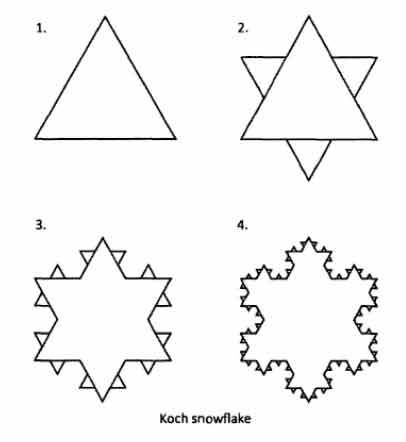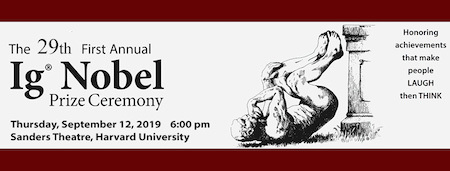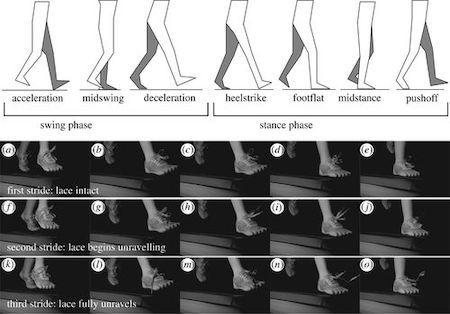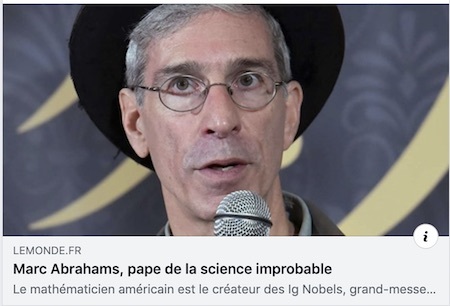Marc Abrahams's Blog, page 138
September 9, 2019
The US Constitution : is it (a) fractal? [study]
If you thought that fractals were restricted to coastlines, clouds and cauliflowers – think again. Over the years (especially since the name ‘fractal’ was coined in the 1960’s ) investigators have been on the lookout for them, and have been finding them in quite unexpected places. Take, for example the US Constitution.
Researcher Daniel M Braun, writing in St. Louis University Public Law Review. 2013, Vol. 32 Issue 2, pp 389-410, explained that fractals might be deeply embedded in US supreme law – and had previously been unspotted :
“ ‘We the People’ are but three simple words that, in a fractal-like fashion, have generated a philosophical harmony that set the tone for the entire Constitution and the nation that it binds. Indeed, the fractal theory helps us to hear all of the Constitution’s tonal elements, understand its composition, appreciate how its clauses work in concert, and identify which of its notes, despite its overall majesty, are off key.”
See: CONSTITUTIONAL PRACTICALITY: STRUCTURE AND COHERENCE IN THE NATION’S SUPREME LAW.
Note: The word ‘PRACTICALITY’ in the linked title, should (almost certainly) be ‘FRACTICALITY’.
[Research research by Martin Gardiner]

September 6, 2019
Fat Relocation Research (and other Disgusting Research)
“Fat Relocation Research—Re-engineering with natural materials” is one of the articles in the special Disgusting Research issue (volume 25, number 4) of the Annals of Improbable Research.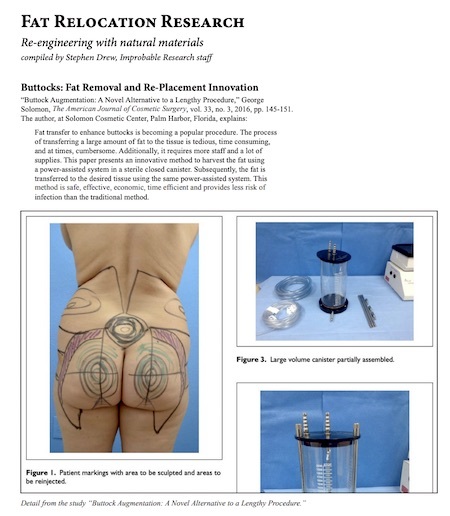
Subscribe, if you dare, to the magazine!

September 5, 2019
The Ig Nobel ceremony happens one week from today.
The 29th First Annual Ig Nobel Prize ceremony will happen one week from today—on Thursday, September 12, 2019, at 6:00 pm (US east coast time)—at Sanders Theatre, Harvard University.
If you want TICKETS, you’d best act quickly. Only a few are still available, from the Harvard Box Office.
Ten new Ig Nobel Prize winners will be revealed. Their prizes will be handed to them by a gaggle of bemused Nobel laureates. There will be a new opera (“Creatures of Habit”). And other stuff.
The ceremony will be webcast live, as it has been every year since 1995.
And two days later, the Lectures at MIT…
This year, for the second straight year, we will also webcast the Ig Informal Lectures at MIT, in which the new winners each give a brief public talk, and answer questions. That event—on Saturday, September 14, 2019, at 1:00 pm, is co-organized by the MIT Press Bookstore. You don’t need a ticket to attend the Saturday MIT Lectures, but seating is limited, so think about getting there a bit early.

Scary animals : a new classification [study]
Scary animals, a new study reveals, can be separated into five distinct clusters :
“(1) non‐slimy invertebrates; (2) snakes; (3) mice, rats, and bats; (4) human endo‐ and exoparasites (intestinal helminths and louse); and (5) farm/pet animals. However, only snakes, spiders, and parasites evoke intense fear and disgust in the non‐clinical population.”
The diagram below shows the ‘mean disgust rating’ plotted against ‘mean fear rating’ for a selection of creatures.
The study revealed some unanticipated results – such as :
“Having been bitten by a dog [also] decreased the mean disgust rating and the more serious the injury, the lower the rating was.”
See: Scary and nasty beasts: Self‐reported fear and disgust of common phobic animals scheduled for publication in the British Journal of Psychology.
Co-author Jaroslav Flegr is a 2014 Ig Nobel Prize winner, for his research on why it is hazardous to own a cat.
Research research by Martin Gardiner

September 4, 2019
Sperm Bags Research (and other Disgusting Research)
“Sperm Bags Research—thinking and looking outside the bag” is one of the articles in the special Disgusting Research issue (volume 25, number 4) of the Annals of Improbable Research.
 Subscribe, if you dare, to the magazine!
Subscribe, if you dare, to the magazine!

September 3, 2019
The Shoelace Catastrophe, examined today at Cornell
Cornell University is hosting a talk today about the how-do-shoelaces-come-untied problem— specifically about the math and physics of it:
MAE Colloquium: “The Shoelace Catastrophe (or a Knotty Problem on a Shoestring“)
Tuesday, September 3, 2019 at 4:00pm, B11 Kimball Hall
ABSTRACT: The accidental untying of a shoelace while walking often occurs without warning. Modeling and simulating the unraveling is an exceptionally difficult task in part because of the wide range of length scales, time scales and parameters. Finding external funding to examine the problem is arguably an even harder problem.
In this talk, we present a set of hypotheses for the series of events that lead to a shoelace knot becoming untied.
The event listing does not specify whether attendees are required to wear shoes.
Thanks to Norm Trigoboff for bringing this to our attention. The topic conjures up a piece of music composed some years ago by Johann Sebastian Bach. The tune will be featured, in a new and rather different context, as part of the opera “Creatures of Habit.” The opera has its premiere on Thursday evening, September 12, as part of the 29th First Annual Ig Nobel Prize ceremony.

September 2, 2019
The mystery of the whirly tube’s missing fundamental mode [study]
The musical instrument shown above is known by various names e.g. the whirly tube, the corrugaphone, the bloogle resonator, the voice of the dragon, the hummer, and even, according to American composer (and parodist) Peter Schickele the “Lasso d’Amore”. For acousticians, it’s noteworthy because the fundamental acoustic mode, that’s to say the note that one would expect to hear given the length of the pipe, doesn’t feature in the whistling. This anomaly, and more, was examined in detail in Voice of the dragon: The mystery of the missing fundamental mode Proceedings of 20th International Symposium on Music Acoustics (Associated Meeting of the International Congress on Acoustics) 25-31 August 2010, Sydney and Katoomba, Australia.
[Research research by Martin Gardiner]

August 31, 2019
The Most Improbable Pope
A headline in the Paris newspaper Le Monde declares that I am the Pope. The Pope of Improbable Science.
You can see this pope on display on September 12, 2019, in the 29th First Annual Ig Nobel Prize ceremony. If you are in Paris (or anywhere else), you can watch the webcast. If you are in Cambridge, Massachusetts, and if you have a ticket, you can see it in person, in Sanders Theatre.

August 30, 2019
Plants can take-up microplastics – should we be happy about it? [new study]
“Waiter, there’s plastic in my lettuce” isn’t a phrase you’d expect to hear very often. Nevertheless, several studies have now shown that plants can, and do, take-up microplastics [MPs] from the soil and incorporate them into stems, roots and leaves. Should we be worried – or happy? The latter is a possibility that should be considered, according to a new investigation from Enyoh Christian Ebere, Verla Andrew Wirnkor and Verla Evelyn Ngozi [Imo State University and the Federal University of Technology, Nigeria] published in the current edition of the international journal World Scientific News.
 The team’s idea is based on previously documented discoveries that plants, such as lettuces*, can take up microplastics via their roots, and incorporate them into the fabric of the plant. But this, say the team, might not necessarily be an entirely bad thing. It can be seen from two viewpoints. In their words :
The team’s idea is based on previously documented discoveries that plants, such as lettuces*, can take up microplastics via their roots, and incorporate them into the fabric of the plant. But this, say the team, might not necessarily be an entirely bad thing. It can be seen from two viewpoints. In their words :
“The effect of plants accumulating MP in plant-soil system is Janus-faced.”
The downside :
“It could be detrimental for human as well as animals [sic] health, as the interaction is contaminating the base of the food-web and conferring new exposure route.”
The upside :
“The interaction could also be good for the environment by acting as a potential phytoremediator of MP through phytoextraction, phytostabilization and phytofilteration.”
See: Uptake of Microplastics by Plant: a Reason to Worry or to be Happy? World Scientific News, 131 (2019) 256-267
Research research by Martin Gardiner
* [ Ref: (in Chinese) Zhou Q, Yin N, Tu C, Luo Y (2019) Uptake and accumulation of microplastics in an edible plant. Chin Sci Bull 64:928–934 ]

August 29, 2019
The Ig Nobel Prize ceremony happens two weeks from today
The 29th First Annual Ig Nobel Prize ceremony will happen two weeks from today—on Thursday, September 12, 2019, at 6:00 pm (US east coast time)—at Sanders Theatre, Harvard University.
A few (not a lot of) TICKETS are still available from the Harvard Box Office.
Ten new Ig Nobel Prize winners will be revealed. Their prizes will be handed to them by a gaggle of bemused Nobel laureates.
Audience Delegations
If you would like your group of five (5) or more ceremony attendees to be recognized as an Official Delegation, First obtain tickets, Then register with Louise Sacco, Official Overseer of the Delegations (phone: 781-690-6621, email: LouiseSacco AT gmail.com). The deadline for registering as a delegation is Wednesday, September 4th, 2019.
Each Official Audience Delegation receives a moment in the sun, so to speak, during the ceremony.
Habits, Habits
The theme of this year’s ceremony (though not necessarily of the things that win prizes) is HABITS. The ceremony will include the premiere of the mini-opera “Creatures of Habit,” about a visit to the (fictional, alas) Museum of Bad Habits.
The ceremony will be webcast live, as it has been every year since 1995.
And two days later, the Lectures at MIT…
This year, for the second straight year, we will also webcast the Ig Informal Lectures at MIT, in which the new winners each give a brief public talk, and answer questions. That event—on Saturday, September 14, 2019, at 1:00 pm, is co-organized by the MIT Press Bookstore.

Marc Abrahams's Blog
- Marc Abrahams's profile
- 14 followers


